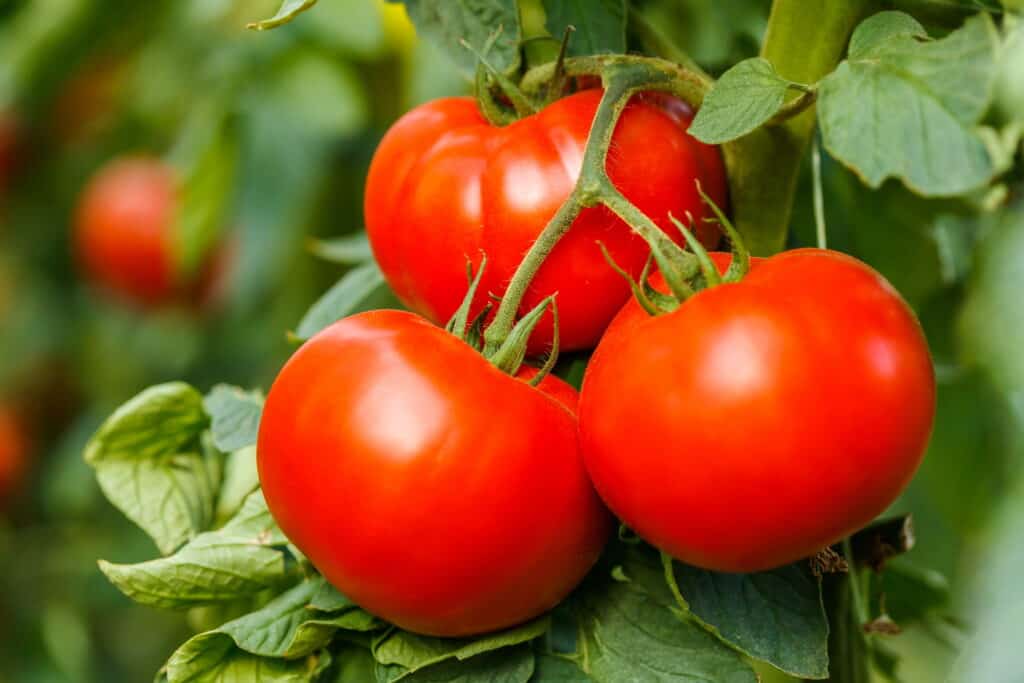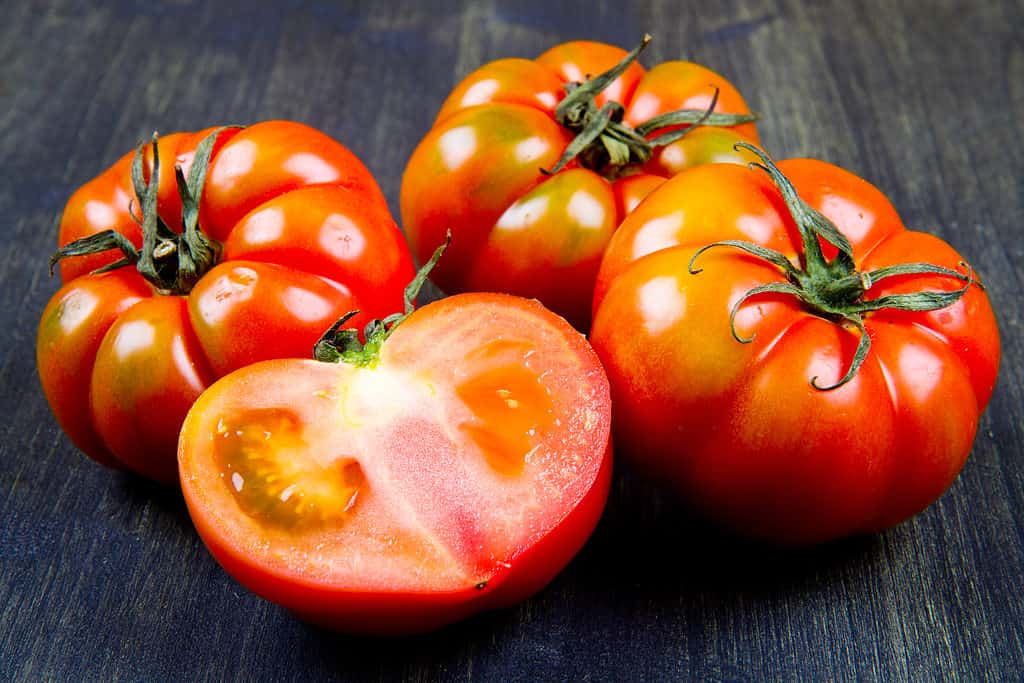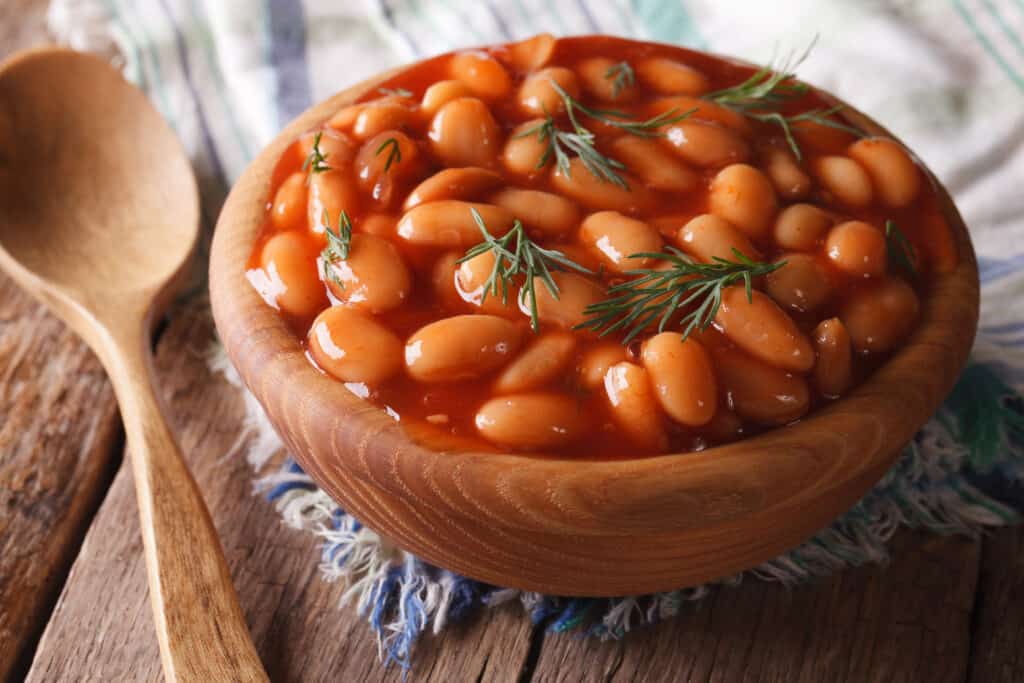Many of us can readily tell the difference between the majority of fruits and vegetables, but we are unsure of how to respond to the age-old question, “Is a tomato a fruit or a vegetable?”
There’s no need to look any further: tomatoes are technically both! Although both fruits and vegetables are crucial to a regular diet, they differ significantly from one another. The categorization of a tomato, however, can differ depending on whether you’re speaking with a botanist, who uses the botanical term, or a nutritionist or chef, who would probably use the culinary meaning.
In this guide, we’ll answer the question: “Is a tomato a fruit or a vegetable?” We’ll also explore some additional information about tomatoes and what makes them such an important part of one’s diet.
Is Tomato a Fruit or a Vegetable?
A botanist would employ the botanical categorization of a tomato. It is founded on the physiological traits of the plant, such as its structure, function, and appearance. By definition, a fruit is the plant’s means of dispersing its seeds. According to botany, a fruit is the seed-bearing product that develops from a blooming plant’s ovary. A botanical fruit develops from the plant’s blossom and contains at least one seed. Given this definition, tomatoes technically fall under the category of fruit because they come from the tomato plant’s blossom and contain seeds. So, to put it simply, a tomato is scientifically defined as a fruit.
In contrast, a vegetable in botanical terminology doesn’t really have a clear definition and is usually just used to refer to the non-fruit edible parts of any plant, which can include its roots, stems, and leaves. So, in terms of botany, foods like apples, strawberries, and peaches as well as tomatoes would be categorized as fruits.
The culinary categorization system, which describes fruits and vegetables in a somewhat different way based on the way the plants are utilized and their flavor characteristics, would be employed by a nutritionist, chef, or even your local farmer. In terms of cooking, vegetables often have a rougher texture and a blander flavor. They usually need to be cooked in meals like stews, casseroles, stir-fries, etc. A fruit, on the other hand, has a soft texture and tends to be sweet or tangy. Fruit is frequently eaten raw, baked into sweets, or canned in preserves.
A juicy, sweet, and raw tomato can be eaten completely raw. But tomatoes are also used in savory meals, thus we typically designate tomatoes as vegetables.

or the tomato (pictured) is scientifically considered a fruit.
©Szasz-Fabian Jozsef/Shutterstock.com
Does The Difference Between the Scientific and Culinary Definition Matter?
Given that the definition of a tomato confounds many people, why do we categorize tomatoes in two distinct ways? These concepts serve distinct objectives. A botanist or scientist can use the botanical categorization, for instance, to identify different tomato varieties, learn how to cultivate and harvest different tomatoes, or learn about the origins of tomatoes.
Because species from the same botanical family may not all have the same nutritional profiles, the culinary definition can be more helpful to the general public, farmers, nutritionists, and chefs. For instance, while they are all members of the same botanical family, cantaloupe melons, watermelons, butternut squash, cucumbers, and pumpkins have diverse nutritional profiles. The following botanical fruits are also regarded as vegetables in cuisine: eggplants, avocado, olives, courgette, cucumber, chili peppers, and squash.
Because most people learn about fruit and vegetables through food education as children, tomatoes are included in the five-a-day vegetable requirements under the culinary definition of a vegetable. A medium-sized tomato or a handful of cherry tomatoes constitutes as one adult serving of tomatoes. Keep in mind to eat a variety of fruits and vegetables to meet your recommended daily intake of five servings each day.
What Are the Different Types of Tomato?
Tomatoes are a wonderfully adaptable vegetable, coming in both huge meaty varieties that can cover an entire sandwich while staying as sweet as sugar and tiny small cherry varieties that, when first ripe, offer a pleasant sour snap. After being classed by size and form, tomatoes can additionally be divided into heirloom and hybrid varieties, determinate and indeterminate varieties, and peel colors. Tomatoes come in five primary varieties: globe, beefsteak, cherry, plum, and oxheart.
Globe Tomatoes
The common grocery store tomatoes that we all grew up with are standard globe tomatoes. These are medium-sized slicer tomatoes that taste fresh and are ideal for salads and other uses. These are spherical and thick-skinned tomatoes. They seldom divide and have a homogeneous, spherical appearance. Most significantly, they are shelf-stable, transport well, and have a wide range of culinary uses. The majority of commercially farmed tomatoes are common globe tomato varieties because of their widespread popularity. Typical globe tomatoes measure between two and five inches in diameter.
Beefsteak Tomatoes
The traditional tomato for eating fresh on a piece of toast or just by themselves right from the vine is the beefsteak-style tomato, also known as the big slicer tomato. Because of their substantial size and flavorful taste, these heavy slicing tomatoes are produced in backyards and market gardens around the world. Numerous varieties feature tiny seed chambers. Beefsteak tomatoes have a notable firmness, which helps them maintain their form when cut into slices. Because of this, using these tomatoes to make burgers and sandwiches is a great option. Typically, beefsteak tomatoes are at least three inches in diameter and weigh up to a pound each.

Beefsteak tomatoes (pictured) are popular for slicing for sandwiches and burgers.
©Luca Santilli/Shutterstock.com
Cherry Tomatoes
Cherry tomatoes are tiny, sharp, and perfect for snacking. This variety of tomatoes is evocative of the wild tomatoes that are still present in South America. Cherry tomatoes are often very juicy and will burst under minimal pressure. Typically, cherry tomatoes have a diameter of less than one inch.
Plum Tomatoes
Oblong plum tomatoes are developed to produce outstanding tomato sauces and pastes. These tomatoes were created specifically to be processed. To enjoy your plum tomato harvest all year long, we recommend roasting, freezing, or canning your yields. The average length of a plum tomato is around two inches and they usually have an oval or cylindrical shape.
Oxheart Tomatoes
The unusual tomato variety oxheart has a shape that resembles a huge strawberry or a heart. They are mostly heirloom varieties, much like beefsteak tomatoes. They are bred for their flavor, size, and thick consistency with tiny seed cavities. Oxheart tomatoes are not lobed, in contrast to beefsteak tomatoes, and they resemble globe tomatoes with a pointy end.
How Tomatoes Are Used in Cuisine
Despite having a very high water content, tomatoes can have a rich taste, especially when cooked. Tomatoes are also incredibly nutritious, providing 17% of the daily recommended dose of vitamin C and having very few calories.
There are so many different ways to eat tomatoes. They can be eaten as a snack or as part of any meal. Fresh tomatoes are offered in the vegetable section, along with processed varieties including tomato paste, canned tomatoes, pasta sauces, and pizza sauces. Fresh or canned tomatoes can be used to make several dishes, such as salsa or pizza. If fresh tomatoes are unavailable or too expensive, canned tomatoes are a viable alternative.
A tomato can be eaten by simply rinsing it in water and biting into it like an apple. Salads, hamburgers, and sandwiches can all be enhanced with sliced tomatoes. Along with cheeses and spices, chopped tomatoes make a delightful addition to pasta. They can also be used to make spicy salsa when combined with onion and jalapenos.
Canning fresh tomatoes is also a fairly simple process. Be careful to acidify them in accordance with the directions in USDA-approved canning recipes. You can preserve them in the form of ketchup, tomato sauce, or even whole. Whole, diced, and pureed tomatoes can all be frozen and are best utilized in hot foods like spaghetti.
Tomato Cuisine Around the Globe
Tomatoes are used in cuisine all across the world, enhancing a range of meals with robust flavor. In French, Spanish, and Italian cuisines, tomatoes are a key component. They are the main component in Caprese salads and a variety of tomato sauces in Italy, from straightforward marinara sauces to sauces with stronger flavors.
In France, tomatoes are used in ratatouille and robust winter casseroles as well as eaten fresh. The Spanish, who are credited with bringing tomatoes to the continent, prefer them in dishes like paella or gazpacho.
Tomatoes are used in practically every stew, broth, and tagine in the Middle East in addition to several salads, kebabs, and other mezze. Every region of Mexico produces a different type of tomato sauce or salsa due to the abundance of tomatoes there. The traditional mole is the most spectacular Mexican use of tomato, where they are cooked with chocolate and spices and served with chicken.

Tomatoes are popularly used in chili dishes (pictured) in the United States.
©Sergii Koval/Shutterstock.com
Where Does Tomato Come From?
The nightshade family is a group of plants with recognized poisonous chemicals that technically includes tomatoes. Because of its past and ties to more dangerous nightshade plants, tomatoes took a while to become widely accepted as a food crop. Although tomatoes can be consumed whole, the plant’s leaves and stems are toxic and not suitable to eat.
The wild plants that are the ancestors of today’s tomatoes thrive in Bolivia, Chile, Colombia, Ecuador, and Peru. The plant’s tiny fruits have very few similarities to the tomatoes grown in gardens today. The tomato fruit we now know and love was created via centuries of planting, growing, and seed-saving throughout the Americas, Europe, and ultimately all over the world. Everyone can now take advantage of their enormous diversity thanks to all this work.
In the Andes, there are still wild tomato plants that maintain a wide genetic variety. In order to enhance features like disease resistance, drought tolerance, flavor, and more, these plants possess highly desired traits that may be crossed with new cultivars. The preservation of tomato biodiversity on farms and in the wild is essential to the development of more hardy tomato varieties under ever-harder growing conditions.
What Are the Health Benefits of Tomato?
The regular consumption of tomatoes has a ton of nutritional advantages.
Reduced Risk of Cancer
Tomatoes are the primary dietary source of the antioxidant lycopene, which has been associated with a number of health advantages, including a decreased risk of cancer and heart disease. It gives tomatoes their vivid red color and aids in shielding them from the sun’s UV radiation. In a similar vein, lycopene can aid in cell damage prevention.
Reduced Risk of Stroke
Increased consumption of tomatoes could lower your risk of stroke, which occurs when blood flow to a portion of the brain is interrupted. According to recent research, tomatoes may reduce inflammation, strengthen your immune system, lower your cholesterol, and prevent blood clots. All of those things could lessen the risk of stroke.
Reduced Risk of Periodontitis
Lycopene can combat free radicals to aid with the gum disorders gingivitis and periodontitis. They may as well possibly prevent oral cancer. However, the significant quantity of acid in raw tomatoes might harm the enamel of your teeth. Immediately following a tasty tomato snack, avoid brushing as this may make it worse. It’s best to wait at least half an hour before brushing.
Improved Heart Health
Your blood pressure and LDL (or bad cholesterol) levels may both be reduced by lycopene. And that could reduce your risk of developing heart disease. Your heart health may also be improved by tomatoes’ other nutrients, such as the antioxidants flavonoids and vitamins B and E.
Improved Immune System
We’ve made it pretty clear thus far that lycopene is a very powerful antioxidant. It combats substances known as free radicals, which can harm your cells and compromise your immune system. As a result, eating lycopene-rich foods like tomatoes can reduce your risk of developing stomach, lung, or prostate cancer. They may also aid in preventing disease and cancer of the cervix, breast, pancreas, and colon.
Skin Health
Most people know that wearing a hat and using sunscreen can protect you from the sun. Well, lycopene from tomatoes could help with that as well! And perhaps in a similar way to how it protects tomatoes. You don’t apply it to your skin, and it isn’t a replacement for sunscreen. However, eating tomatoes can provide skin benefits from the inside.
Lung Health
Tomatoes can be beneficial for those who have asthma and may help prevent emphysema, a disorder that gradually affects the air sacs in your lungs, according to several studies. That might be because antioxidants like lycopene, lutein, and zeaxanthin work to combat the toxic components in cigarette smoke, which is the main cause of emphysema.
Vision Benefits
Lutein and zeaxanthin, which are found in tomatoes, may help shield your eyes from the blue light produced by digital gadgets like smartphones and laptops. Tomatoes can also reduce headaches brought on by straining of the eyes. And according to some studies, they may even lower your risk of developing an advanced stage of age-related macular degeneration, the primary cause of blindness in the United States.
Conclusion
To summarize, although tomatoes are technically a fruit, they are typically served in savory recipes. This is why they are sometimes referred to be vegetables from a culinary standpoint. But when tomatoes taste as wonderful as they do, who cares? We can all agree that tomatoes make excellent easy snacks, taste great in stews, and are a good food choice since they give us fiber, vitamins, and minerals.
Tomatoes are pretty interesting little (or big) fruits. Despite being technically fruits, tomatoes can be used for a wide range of dishes, be they sweet or savory. These versatile fruits can be used as vegetables in different dishes and vice-versa. There’s really nothing quite like the incredible tomato!
The photo featured at the top of this post is © iStock.com/Grahamphoto23
Thank you for reading! Have some feedback for us? Contact the AZ Animals editorial team.







